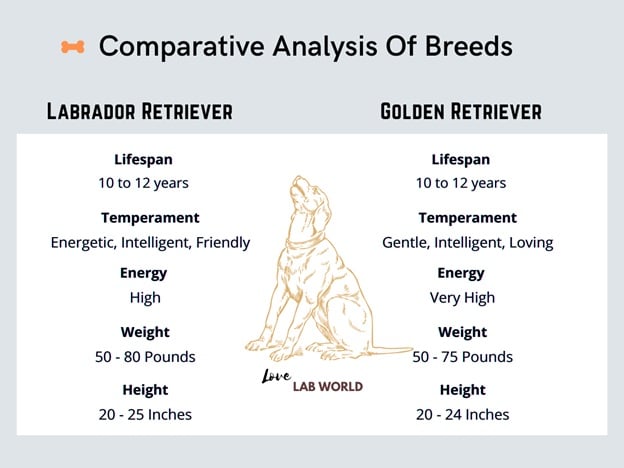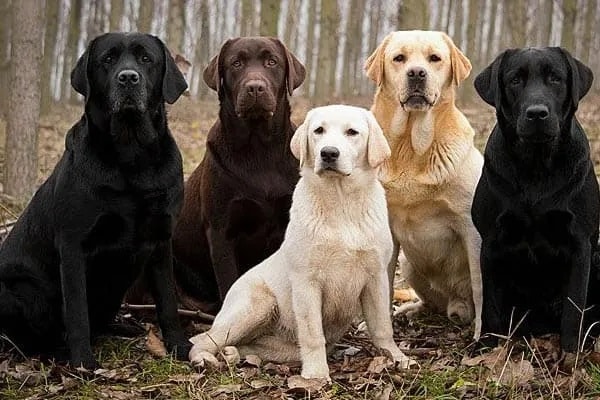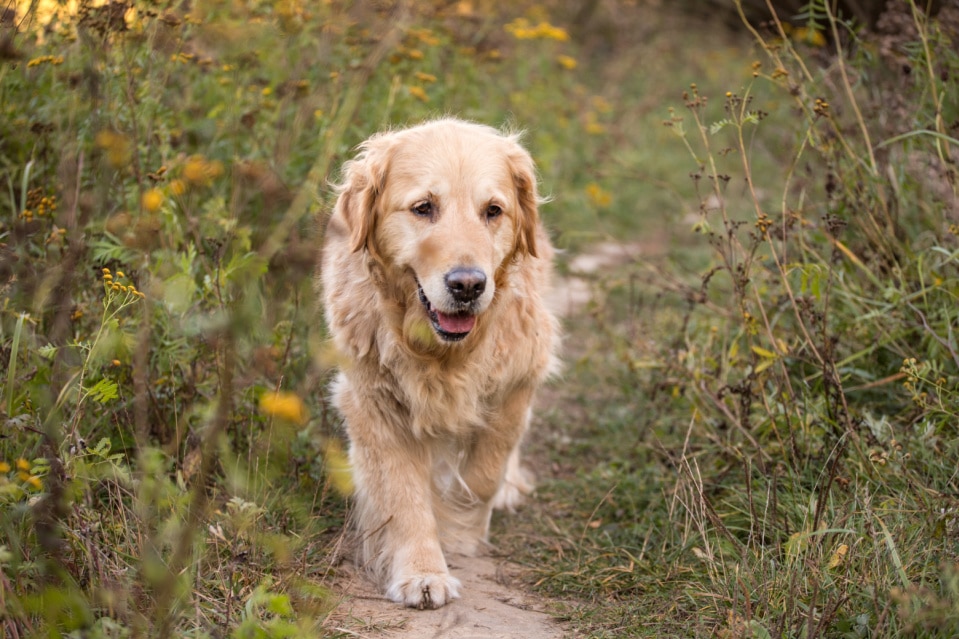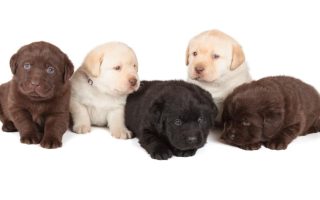What you mean makes sense. It does happen. There was a time when I was also confused about the distinction between the two Labrador And Golden Retriever. The Labrador retriever is a medium-sized, short-haired dog breed. The Labrador retriever was bred in England in the 1800s to retrieve waterfowl that were shot down.
But do you know now the differences between them or how do you differentiate between them?
Both Labradors and golden retrievers share some similarities as well as some differences, which is why they often confused. Both dogs have incredible abilities. Expect to hear that a lot since both of them contain so many positive qualities that I wish to share with you.
The purpose of today’s guide is to help people make their decision about their next pet, whether a Labrador Retriever or Golden Retriever, and to educate those who interested in learning more about them. Read along to learn more.
It is no surprise that both breeds renowned around the world as being ideal family pets. However, they do have different levels of energy that a person can expect from each breed.
Golden retrievers certainly need more grooming than labradors. Compared to the Golder Retriever, the Lab has more energy and is a more eager hunter.
Golden Retriever And Labrador Retriever Breed Difference
Since Labrador retrievers and golden retrievers are similar in appearance and temperament, it is common for people to question the differences between the two.
As retrievers, Goldens and labs tend to be excellent hiking partners, athletic companions, car buddies, and members of the family.
Besides highlighting the differences, we will also discuss the similarities shared by both breeds.
Comparative Analysis Of Breeds

A Sneak Peek Into Breed History
While these curious canines may look similar, they come from very different parts of the world and have very different histories.
It’s no surprise that both breeds evolved into wonderful family pets despite being born and bred under similar working conditions.
Labrador History
Among all dog breeds, Labradors have held the top spot for a number of years when it comes to sheer numbers. St. John’s Water-Dogs and other local dogs the first breeds of Labradors developed in Newfoundland, Canada.
Due to their love of water and the breed’s impressive retrieving abilities, hunters who introduced the breed to North America and the UK made them ideal waterfowl retrievers. The Labradors used to support fishermen in retrieving nets and dragging gear at that time. Fishermen adored him, and he loved catching fish and collecting ducks.
Golden Retriever History
Its origins can found in the 19th century after the breed’s creator, Lord Tweedmouth, crossed his retriever with a British Water spaniel during a visit to “Scotland”. The Golden Retriever we know today is the result of his (Lord Tweedmouth) dog breeding experience.
Gun dogs (Golden Retrievers) were the perfect hunting companions, due to their ability to locate their master’s catch, retrieve it intact, a quality called “soft mouth” in the dog world.
After a half-century of perfecting the dog, Lord Tweedmouth’s lineage carried him to the United States, which was the place the Golden Retriever began to gain popularity.
Aside from his excellent work ethic, his grace and beauty also won him fans in the United States. The Golden Retriever rose to fame following the adoption of “Liberty” a golden retriever dog by former U.S. president, Gerald Ford. TV showed her to be the perfect family pet with a very happy disposition.
Labrador Retriever
Type
You can either choose to have a labrador retriever that is either:
- English Labradors – also called show dogs
- American Labradors – the working labrador breed
A Labrador retriever of the American type is smart, energetic, and highly affectionate. On the other hand, the English Labrador is generally bigger, gentler, and more docile compared to the American Labrador.
Appearance
This breed comes in a variety of colors like yellow, black, and chocolate, making it quite distinctive. There is another color, however, that is golden blonde and has several shades.

Many reasons contribute to how labs and golden retrievers resemble each other. There is only a half-inch difference in height between these two medium-size dogs; the labrador stands 24.5 inches at the withers, while the golden retriever stands 24 inches. Undertanding Labrador And Golden Retriever weight.
On average, Labradors weigh 5 pounds more than Golden Retrievers. As for their weight, they are about the same as a bag of sugar, so there isn’t much difference between them.
An identical undercoat and outercoat cover the labrador, except for the outer coat, which is denser and shorter. In some ways, the labrador’s coat works as a swimsuit, preventing body heat from escaping into the freezing waters.
They both have water-repellent coats, however, the Lab has an ice-resistant coat as well.
Temperament
In accordance with the breed standard, the ideal temperament is to be affectionate, sociable, obedient, and docile.
People solely drawn to the Labrador because of his gentle disposition, sharp intellect, and ability to adapt. Their sweet nature and outgoing personalities make them a joy to live with. I love how friendly and open they are to new people.
It’s no wonder they can trained easily because of their sharp intellect and high energy levels. Additionally, they are always happy to sit at home with family for family movie night so you don’t have to worry about loneliness at all.
There are people who claim their color determines their temperament, but that is not scientifically supported. A common observation among veterinarians, though, is that every labrador is distinctive and unique.
The temperament of some labs varies, some can be more mellow while others are more energetic. Even if your lab is a bit of a prankster, you can still have an enjoyable experience. One thing always remains the same regardless of the personality your lab puppy develops – they make excellent family pets.
However, lifestyle should always considered prior to owning a dog – regardless of what breed you choose. Children tend to prefer Labradors, and senior couples tend to prefer golden retrievers.
Trainability
It is easier to train labs since they are smart dogs. Labs love people and are social by nature. It is quite possible for them to develop behavioral problems in an isolated environment. In order to be a responsible pet owner, you must acknowledge and understand your pet’s natural instincts and provide opportunities for them to express themselves.
Grooming
It is solely their double coats of both breeds that provide them with weather resistance in the Highlands of Scotland and the Canadian arctic conditions.
Firstly, there is a soft undercoat that provides protection against frost and then there is a topcoat shorter than that of Golden Retrievers. The lab sheds its undercoat, too, in warm weather, just like the Golden Retriever.
In light of the type of coat they have, one wonders if they’re easy to groom?
There is little maintenance required in lab coats during the non-shedding season, but what happens when they molt?
The Labrador doesn’t possess any fluffy ears, neck, or tail as Goldens do, resulting in no ear trimming needed. The downside is, even though they have a short-haired coat, the double-coated one requires regular grooming.
Similarly, they must brushed every week or two, more frequently when they shed, which occurs around two times a year.
Slicker brushes are great for grooming in general, however, some people prefer to use combs for the final grooming step on their pets. As with Golden Retrievers, Labradors do not have long hair that should ever shaven.
As winter approaches, their undercoats thicken and become dense for warmth, and then, as the seasons change, they shed their undercoats.
This process (shedding) can take 3-4 weeks, at which point he will need grooming on a regular basis on a three-to-four times weekly basis.
As nails form another important part of their body, let’s talk a little about them as well. Grooming routines should also include nail trimming. In general, labs need less bathing than golden retrievers, which means owners aren’t as worried about overall maintenance time because they don’t need to bathe them as frequently.
Health Concerns
While labrador retrievers are among the best dogs, they have some health issues – some of them are as follows:
Obesity – Breeds such as the Labrador retriever are prone to obesity. The breed should not allowed to free-fed, as it is prone to overeating. Keeping them at a healthy weight means limiting their treats as well.
Allergies – The substances in the environment often cause allergies in Labrador retrievers. If your lab has itchy skin, there may be a connection with pollen, dust mites, and molds.
Hip Dysplasia – Many large dog breeds suffer from this health issue.
Golden Retriever
Type
Golden retrievers can divided into 3 types. Golden retrievers actually come in three different colors, golden, light golden, and dark golden, despite people’s perception that they all look alike.
The main different types include the following:
- American
- English
- Canadian
Appearance
A golden retriever looks more elegant due to its slimmer appearance than the Labrador, while the Labrador appears to be bulkier, largely because of its coat.

Golden retrievers, on the other hand, have a fur coat and an undercoat for warmth, while their outer fur is more elongated, shinier, and smoother, elevating their appearance. Upon reaching maturity, the Golden Retriever’s hair changes to a white or dark golden color, while the Labrador keeps his color except for some gray hairs.
Golden Retrievers have an equally elegant tail; it is long and thick, with long hair that dangles; very much like a human arm, it sways when he walks. In contrast, the tail of the labrador is different. Short and thick, it’s similar to an otter’s tail.
It was easier for him to swim in the water because of his thick tail. In a sense, their tales are rudders that guide him through the water. It’s easier for the fisherman to pull him out by his tail rather than having to grapple with him if he gets stuck.
Temperament
When it comes to temperament, it is rare to find a more curious, friendly, and enthusiastic pet. Early in their lives, they are perfect for playing with children in the backyard. Conversely, Golden retrievers become progressively calmer and mellower as they age.
Working retrievers by nature, golden retrievers have huge amounts of energy and require a great deal of exercise. A dog like this is a good fit for someone who leads an active lifestyle and enjoys having someone by their side to spend time with while doing things together. It’s not easy for them to live by themselves since they too attached to their humans.
Typically, golden retrievers were bred as working dogs, which is why they enjoy fulfilling their owners’ needs and being of service, such as fetching the morning paper or getting the kids up in the morning. The happy disposition of golden retrievers often attracts other people’s attention on walks – they enjoy socializing both with people and other animals.
Although they don’t make the most reliable guard dogs – like walking away from or even playing with intruders if they find one in your yard.
They are incredibly loyal, smart, and calm, all qualities that make them excellent service dogs.
Trainability
Golden Retrievers are easy to train since they are characterized by four main characteristics:
- The Golden Retriever is one of the smartest dogs on the planet, ranking among the top five smartest dogs in the world.
- Goldendoodles are devoted to their owners and love to please them.
- Positive reinforcement works best for them, and they adore snack foods, which in turn motivates them to do better at training.
- Breed experience plays a huge role – they are easy to train because they were bred over many generations.
Grooming
In comparison to labrador retrievers, golden retrievers require more maintenance than just brushing. Golden retrievers are known for their long feathered coats, which require special care and attention. In the season of shedding, Golden Retrievers tend to shed more than labradors because of their long fur.
A twice-a-month trim is necessary in order to prevent the hairs from getting too long.
A Golden Retriever’s longer and silkier coat not only requires regular trimming but also needs bathing more often because of its lengthy and shiny hairs. Dogs should be bathed on average every 4 to 6 weeks.
It is recommended that you bathe him every four weeks to keep him healthy. To keep him looking and smelling fresh between walks, try dry dog shampoo, doggy wipes, or even dog scents. Bathe your dog only as much as is recommended, as this may damage their natural coat oils and lead to skin irritation.
When it comes to top coats, slicker brushes are essential. Steel tooth combs are also helpful in this regard. We recommend that Golden Retrievers be brushed twice a week. The longer hairs on a golden must also be trimmed with scissors, especially thinned shears.
A number of areas need to be trimmed with scissors regularly, including the following:
- Ears
- Neck
- Feet
- Tail
Besides maintaining the coat, basic grooming needs for golden also include nail trimmings, baths, ear, and teeth cleaning.
Keep in mind – that there is a high chance of an ear infection in dogs with dropped ears.
Health Concerns
All dog breeds come with health risks, but Goldens have a higher incidence than most others. You should be aware of the following golden retriever health problems when you own one.
Skin Conditions – Golden retriever dogs have a thick undercoat of fur that acts as insulation and a more substantial outercoat. Both of these factors provide the perfect conditions for potential bacteria. Keeping the dog clean, groomed, and protected from parasites might help in this case.
Hip Dysplasia – Hip dysplasia is a major health concern in Goldens. Similar to the human hip, dogs’ hips are ball-and-socket joints that allow the femur head to freely rotate inside the pelvic socket. Strong ligaments hold the bones firmly in place. When the hip socket or femoral head are misaligned, which results in excessive ligament stress leading to uneven bone density.
If your dog is suffering from symptoms of hip dysplasia, he may have trouble performing the following tasks:
- Jumping
- Stepping upstairs
Respiratory and Cardiovascular Problems – Just like their large breed counterparts, Golden retrievers are susceptible to a number of diseases relating to their hearts, lungs, and circulatory systems. “Subvalvular aortic stenosis” accounts for the majority and causes the most harm. It is characterized by narrowing of the blood vessels responsible for transporting oxygen from the heart to the body.
Final Thoughts
Despite their differences, both breeds are exceptional, ranking high on the list of the world’s most popular breeds.
A dog from either of these breeds would be a great addition to any family. Irrespective of whether you are seeking a Golden Retriever or a Labrador Retriever, chances are you’ll end up with a beautiful dog that everyone will admire. It’s never too late to adopt a cross between two breeds if you can’t decide between them.
We hope this guide helps you decide whether a Golden Retriever or Labrador Retriever is right for you.







